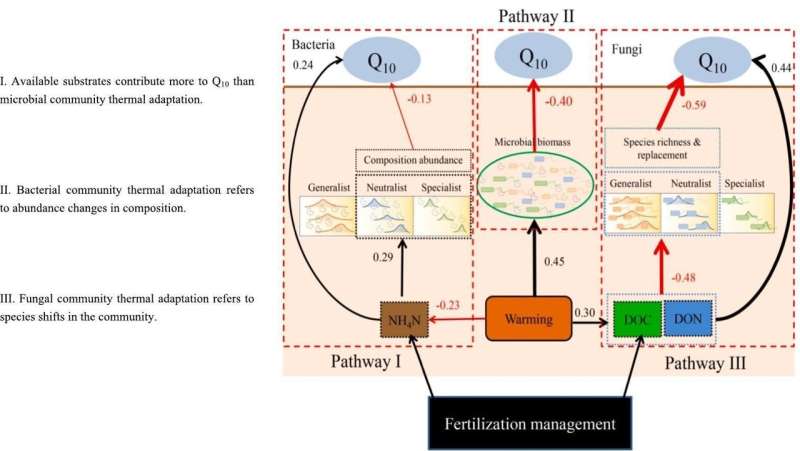This article has been reviewed according to Science X's editorial process and policies. Editors have highlighted the following attributes while ensuring the content's credibility:
fact-checked
peer-reviewed publication
trusted source
proofread
Researchers study temperature sensitivity of soil microbial respiration under climate change

Under field conditions, soil respiration consists of heterotrophic respiration by soil microbes and autotrophic respiration by plants. Temperature sensitivity (Q10) is a common method to describe proportional changes in soil heterotrophic respiration in response to warming. However, it remains unclear how the available substrate and the soil microbial community regulate the Q10 of soil microbial respiration under natural warming conditions.
In a study published in Science of The Total Environment, researchers from the Xishuangbanna Tropical Botanical Garden (XTBG) of the Chinese Academy of Sciences and the Anhui Academy of Agricultural Sciences presented the first study focusing on the community thermal adaptation to the Q10 of soil respiration based on the niche breadth of the microbial community composition.
The researchers conducted a long-term field experiment consisting of two years of soil respiration observations, combined with a soil available substrate and microbial community thermal adaptation analysis under seasonal warming conditions.
They first analyzed the contribution of microbial properties and soil water content, NH4-N, NO3-N, dissolved organic carbon (DOC), and dissolved organic nitrogen (DON), and temperature to soil respiration. They found that soil respiration under changing temperature was mainly caused by variation in soil microbes and soil available substrate.
They also analyzed the contributions of soil water content, temperature, DON, DOC, NH4-N, and NO3-N to bacterial and fungal community structure to characterize the community thermal adaptation to changing temperature under field conditions. They found that temperature was the main factor in structuring soil bacterial and fungal community.
The results indicated that the available substrate contributed more to the regulation of the Q10 of soil heterotrophic respiration than the thermal adaptation of the microbial community. Fertilization management had a stronger effect on soil available substrate than temperature.
"We can say that the change of available nitrogen and DOC, mainly caused by fertilization management, contributed more to the regulation of Q10 of soil microbial respiration than the thermal adaptation of microbial community," said Liu Changan of XTBG.
More information: Zhibin Guo et al, Changing soil available substrate primarily caused by fertilization management contributed more to soil respiration temperature sensitivity than microbial community thermal adaptation, Science of The Total Environment (2023). DOI: 10.1016/j.scitotenv.2023.169059
Journal information: Science of the Total Environment
Provided by Chinese Academy of Sciences




















